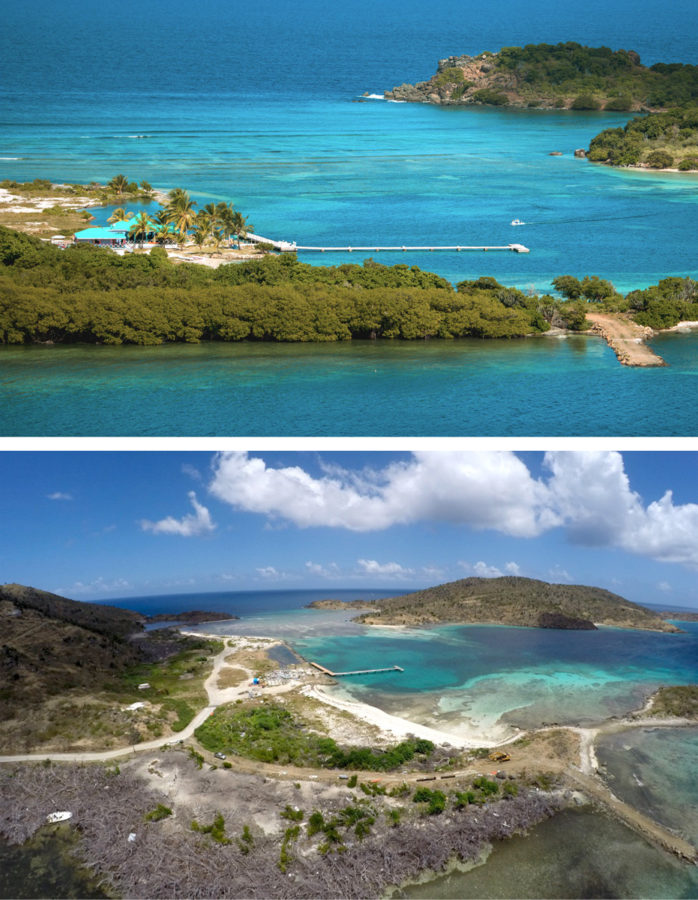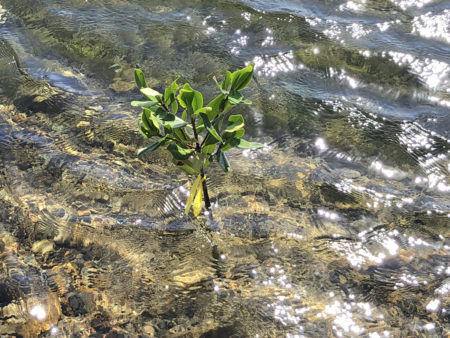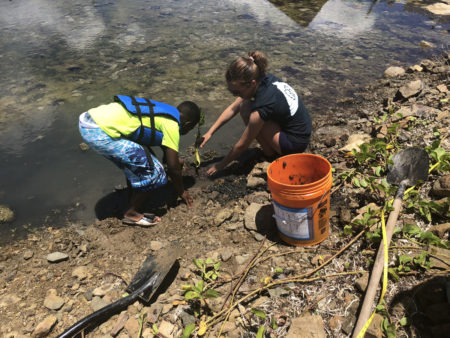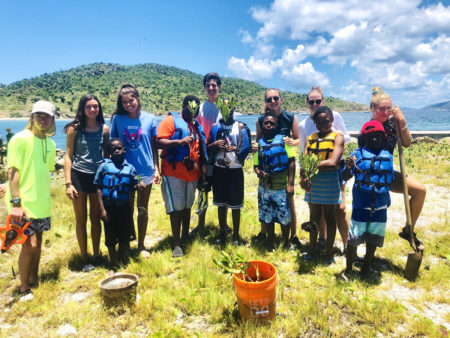Wednesday, September 6, 2017 was a terrible day for the British Virgin Islands.
With peak-sustained winds measured at 185 mph and momentary gusts exceeding 225 mph, Hurricane Irma caused catastrophic damage, turning the once vibrant green islands into a dull brown mess.
As conservation professionals, much of our time is spent on convincing people not to encroach upon or damage our important mangroves. I never dreamt that in just one day a “non-human” named Irma could deliver such a devastating blow to the BVI’s entire mangrove forest.
Salt-tolerant plants that grow in or near the water’s edge, mangroves provide countless benefits to nature and humans. Mangroves provide habitat and nursery areas for fish, playing an important role in fishery and coral reef health. Additionally, they help maintain good water quality by providing a catchment area for runoff from higher ground. They also act as a buffer for storm surge – wind and waves – protecting coastlines.

Conservation starts with scientific information and planning
In April, with the financial support of the BirdsCaribbean Hurricane Recovery Fund, the Jost Van Dykes (BVI) Preservation Society carried out a rapid assessment of the hurricane-damaged mangrove areas in the British Virgin Islands. The Society also received technical assistance from Dr. Gregg Moore, a restoration ecologist from the University of New Hampshire with vast experience in evaluating post-hurricane mangrove systems in the Caribbean,

Land and boat-based rapid assessments were combined with UAV (drone) based aerial surveys. Dr. Moore compiled the results of the surveys into a report, which was provided to key BVI government agencies and non-governmental organizations. This report serves as a useful tool for informing future mangrove restoration.
The report confirms what we might have already guessed: about 90% of mature red mangrove trees that form the coastal fringing system have been defoliated and are dead, with very few exceptions. The damage to BVI mangroves is a serious ecological blow to the system, but the storm also took with it the flowers and fruits that we would expect to be the next generation of mangrove trees.
Nevertheless, the study offers some optimistic findings and some important lessons for the BVI and other Caribbean islands that may suffer serious storm damage. The “take home” lessons include:
Lesson 1: “Learn to See the (Mangrove) Forest Through the (Dead) Trees”

Let’s repeat together! DO NOT CUT DOWN THE MATURE DEAD MANGROVE TREES.
There are many reasons to support the recommendation to not cut the standing mangrove deadwood whenever possible:
- Mangroves provide valuable habitat for wildlife such as birds and invertebrates;
- As dead mangrove trees decompose, they release energy and return essential nutrients and carbon to the system;
- Mangrove’s physical structure is mainly intact and still buffers wave and storm energy, and helps hold peat and sand in place along fragile coastlines; and
- That structure also protects animals and helps trap and protect mangrove seedlings that will regenerate the forest naturally.
Any cleanup of debris should be limited and very carefully managed to avoid further damage. Foot traffic and the hauling of cut wood can trample fragile seedlings.
Even if most of the mature trees are dead, the mangroves are still a forest. Since Gregg’s visit, we have carried out monitoring of as part of a UK Darwin Initiative-funded ecosystem resilience project. During each visit I see perching birds, which help spread forest seeds, resting on the tops of dead trees; herons stalking the crabs that live around the prop roots; and seabirds foraging in nearby marine systems that are supported by our mangroves.
The mangrove forest and the environment are damaged, but the ecosystem is still alive, and needs a chance to recover.
Lesson 2: “The Children are the Future”
Despite severe damage to the mature canopy, virtually every site visited in the BVI had a significant understory of live, rooted seedling plants. Albeit quite young and short today, these young plants are the future of BVI’s mangroves and should be carefully protected.
We should get young humans involved. They will be the future stewards of this important ecological resource, and should play an important role in mangrove restoration work.
Lesson 3: “Think global, but Act/Grow Local”
There is a wide body of literature on mangrove and coastal habitat restoration available. Learn from others around the world about what works (and what does not) in mangrove restoration. Find seedlings that are available locally, or as close to your degraded site as possible. Importing plants carries the risk of introducing invasive species, diseases and other potential calamities.
Lesson 4: “It Takes a Village”

Involve everyone. Or as many people as possible.
I was pleasantly surprised by the level of interest the stories about our mangrove work in local news publications and on social media generated in the BVI. Undoubtedly, some of the conservation community’s messages about the importance of mangroves have gotten through over the years!
Mangrove restoration across the BVI is going to be an enormous effort. We are excited to be partnering with the Rotary Club of Road Town. The Club plans to help turn mangrove conservation and re-planting activities into a territory-wide effort, involving individuals, community-based organizations and businesses.
We sometimes feel isolated on our tiny, individual islands, but we need to think in terms of broader landscape or seascape-level management. Our BVI-wide rapid mangrove assessments were useful in identifying mangrove sites within the BVI that can be used for the sustainable recruitment of plant stock for restoration and conservation efforts. The slogan “stronger together” is more than just a catch phrase.
Many thanks to generous donors to BirdsCaribbean’s Hurricane Relief Fund for supporting our mangrove restoration and education efforts! In October, Dr. Moore will return to Jost Van Dyke, BVI to assist the JVD Preservation Society and Rotary Club of Road Town in hosting a Mangrove Restoration Workshop. JVD Preservation Society is working to establish a small mangrove nursery site on the island of Jost Van Dyke.
By Susan Zaluski, Director, Jost Van Dykes (BVI) Preservation Society.
